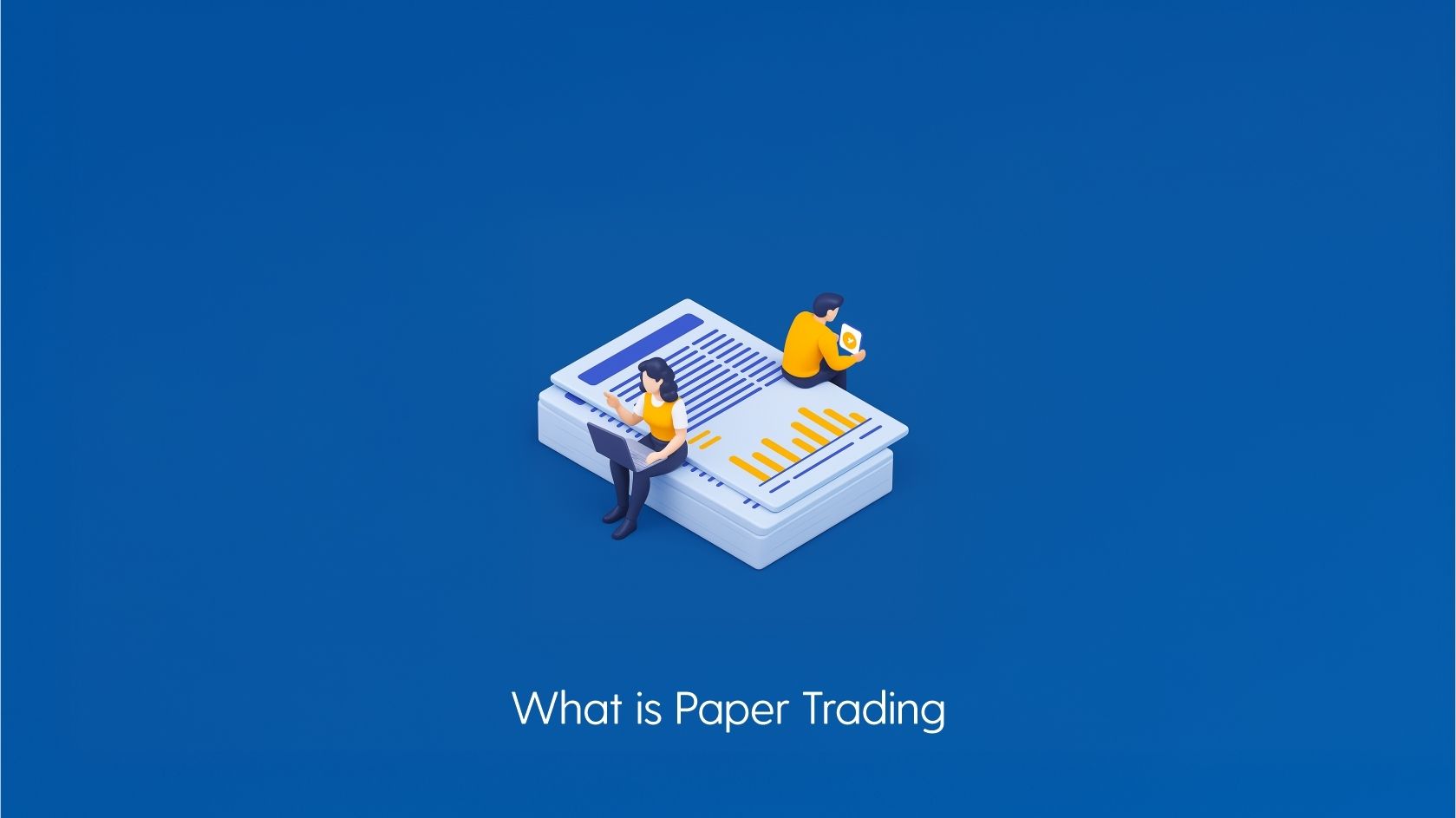- Home
- Blog
- Demat Account
- Paper Trading: What It Is, How to Start, & Everything You Need to Know
- Paper Trading: What It Is, How to Start, & Everything You Need to Know
Paper Trading: What It Is, How to Start, & Everything You Need to Know

- Published Date: November 14, 2025
- Updated Date: November 21, 2025
- By Team Choice
Before you risk real money in the stock market, imagine having a way to trade stocks, test strategies, and learn market behaviour, all without losing a single rupee. That’s exactly what paper trading offers.
In simple terms, paper trading allows you to practice buying and selling securities using virtual funds, replicating real market conditions. It’s one of the safest and most effective ways for beginners and seasoned traders alike to refine their strategies, understand price movements, and build confidence.
In this blog, we’ll explain the paper trading meaning, what is paper trading in stock market, how it works, why it matters, and the key pros and cons to know before you start.
What is Paper Trading?
Paper trading is a practice method that allows beginners to explore how trading works without putting real money at risk. It provides investors with the opportunity to test various trading strategies, learn how to select the right stocks, and determine when to enter or exit a trade, all within a simulated environment.
In short, paper trading refers to practising the art of trading in a financially risk-free environment, a smart first step before entering live markets. However, it should not be substituted for real-time trading psychology.
How Does Paper Trading Work?
Paper trading works by simulating the experience of real-world trading through a virtual trading platform. When you sign up for a paper trading account, you receive a set amount of virtual money that you can use to buy and sell securities like stocks, ETFs, or mutual funds.
How To Start Paper Trading
Learn how to paper trade step by step:
- Create an account: Register on a free paper trading platform or broker app that offers a demo trading feature.
- Get virtual funds: You’ll be credited with a virtual balance to start your simulated trades.
- Select your trades: Choose which stocks or assets you want to buy or sell, just as you would on a real trading platform.
- Monitor performance: The platform tracks your profits and losses in real time based on live market data.
- Refine your strategy: Review your trading history, identify mistakes, and improve your approach before moving to real investments.
Key Features of Paper Trading
Here are the key features of paper trading:
- Real-Time Market Data: Most platforms provide live or delayed market data so users can experience actual price movements while placing trades.
- Virtual Funds: Traders receive a fixed amount of virtual cash (for example, ₹1,00,000 or $100,000) to practice trading and monitor gains or losses as if using real money.
- Replicated Trading Interface: Paper trading accounts often mirror real trading platforms, allowing users to place orders, set stop losses, and track performance in a familiar environment.
- Performance Analytics: These tools track every trade, helping traders review strategies, analyse profit and loss trends, and improve decision-making skills.
- Multiple Asset Options: Many free paper trading platforms allow users to experiment with different instruments, including stocks, ETFs, commodities, and currencies.
- Risk-Free Learning: Since trades use virtual money, users can make mistakes, learn from them, and build confidence without the fear of financial loss.
Importance of Paper Stock Trading
Here’s why paper trading is important for every aspiring trader:
1. Builds Practical Experience: Paper trading lets you experience how the market works in real time. You learn to read charts, place orders, and observe how prices react to market news or trends.
2. Teaches Risk Management: Since you trade with virtual funds, you can test stop-loss levels, position sizing, and diversification strategies without losing money. This helps you understand how to protect your capital in real trading.
3. Develops Trading Discipline: Practicing on a paper trading platform helps traders control impulsive decisions. It teaches patience, planning, and emotional discipline, all vital skills for successful trading.
4. Test Strategies Safely: Before implementing a new strategy in live markets, you can test it through paper money trading to see how it performs under different conditions.
5. Bridges the Learning Gap: For beginners, paper trading connects theoretical knowledge with real-world practice, making it easier to transition to live trading with confidence.
Advantages And Disadvantages of Paper Trading
Like any learning tool, paper trading has both strengths and limitations.
| Advantages | Disadvantages |
|---|---|
| No Financial Risks: Paper trading lets you practice without the fear of losing real money. You can make mistakes and learn freely. | Unrealistic Risk Behaviour: Many beginners take risks they wouldn’t take with real money, which could lead to overconfidence when switching to actual trading. |
| Real-Market Experience: Paper trading platforms mirror live market conditions, helping you understand how prices move, how orders are executed, and how your strategies perform in real-time. | Execution Differences: In real trading, factors like slippage, brokerage fees, and order delays can affect results. These things are not always reflected in paper trading accounts. |
| Confidence Building: Practising with paper money trading allows beginners to gain confidence before entering live markets. | Limited Real-World Impact: While paper trading helps you learn strategy and timing, it doesn’t fully prepare you for managing real profits, losses, or investor psychology. |
| Strategy Testing: Traders can test different strategies, such as swing trading, intraday, or positional, to see what works best for them. | False Sense of Security: Paper trading can create a false sense of security, as success in a virtually risk-free simulation doesn’t always translate to real-market performance. |
| Skill Development: Paper trading helps you learn how to interpret charts, analyse company performance, and evaluate market trends accurately. | No Emotional Pressure: Since no real money is at stake, traders don’t experience the emotional highs and lows that come with actual profits or losses. |
Conclusion
So, what is paper trading in a gist? It’s a practical method to understand market dynamics and develop your trading skills. By simulating trades with virtual money, you can sharpen your strategies, learn from mistakes, and prepare for real-world investing with greater confidence.
If you’re new to the stock market, start with free paper trading to build a solid foundation before moving to live trades. Remember, mastering trading takes time, patience, and practice. Once you’re confident, you can open a Demat account with Choice and gradually transition to live trading.
FAQs
1. Is Paper Trading Risk-Free?
Yes, paper trading is completely risk-free since you’re not using real money. It’s a safe way to practice and learn market mechanics. However, it should not be substituted for real-time trading psychology.
2. Is Paper Trading Legal?
Yes. Paper trading is legal and widely encouraged for learning purposes.
3. Can I Earn Real Money in Paper Trading?
No, you can’t earn real money. The profits and losses are simulated using virtual funds.
4. What Are The Benefits Of Paper Trading?
It helps you understand market trends, test trading strategies, and build confidence without any financial loss.
5. What are The Risks in Paper Trading?
While there’s no financial risk, the main drawback is overconfidence and a lack of emotional engagement, which can differ from real trading situations.
Disclaimer: “Paper trading is for educational purposes only. Success in simulations does not guarantee success in live markets, which involve real financial risk.”
Recommended for you

FII DII Data - Live Data

Share Market Prediction For Tomorrow

Market Prediction Today (24th December 2025)
